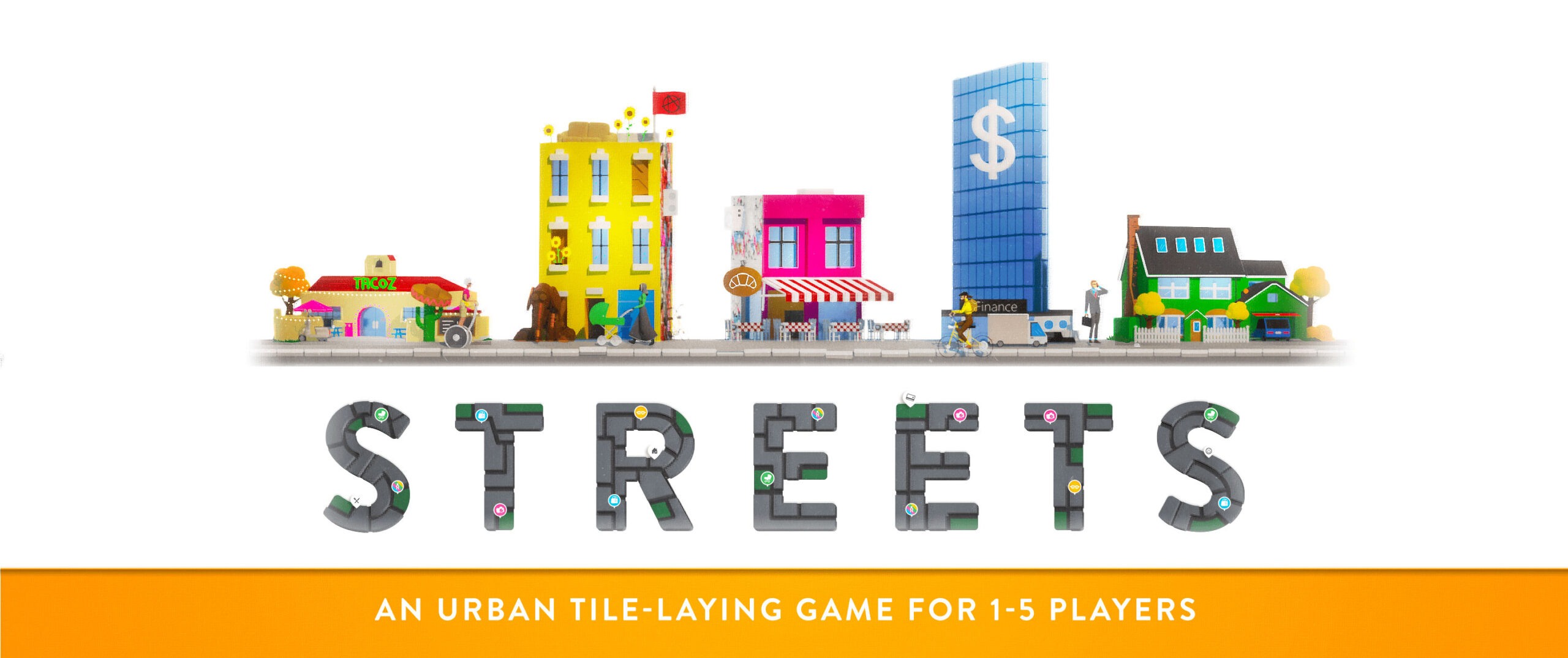
From hipsters, shoppers, families, and tourists, the crowds are coming to your Streets. Develop a constantly changing city by investing in building properties, attracting the masses, and playing smart to raise the valuation of your buildings. Streets will grow and evolve in the blink of an eye. With clever Tile Placement and great attention to the Set Collection property valuation rules, see your profits multiplying and become the Streets legend!
Streets is a City Building game for one to five players, best played with four. It may take longer the first time you play the game, but once you are familiarized with the rules, it is a fast-paced game that lasts under thirty minutes.
Note that this review is based on the Deluxe Kickstarter Edition of Streets that come with deluxe components, mini-expansions, and rule variants.
Gameplay Overview
During the game, players will collectively build a City and compete to sell their buildings for the most money. Buildings should be placed in locations that increase their value and attract crowds of people from other streets to maximize profit. There are four types of Buildings and meeples: hipsters, tourists, family, or shopping areas. Building valuation rules are usually determined by a Set Collection of specific types of area signs or people. Still, there are several other unique valuation rules. Choosing the right location is crucial for the success of a building. Building symbols indicate which type of People will be attracted to it. It is common for buildings to earn money by being located on streets with specific symbols.
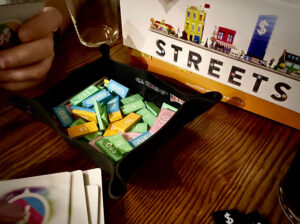
Buildings are populated with People (wooden meeples) according to their Symbols. Persons increase a building’s value by $1. After a street has been scored, People will try to move to another Building. Some buildings can significantly increase their value when crowds gather on them. Each tile has a large Symbol representing the Building it depicts. It can be helpful for all players to look at this information to predict what people will play and what kind of Building they will get next.
The game plays as follows. During your turn:
- Build a Building: Place a building from your hand on the City following placement rules (the tile street needs to be adjacent to an existing street). Add an Ownership Sign to own the property. If you run out of signs, you must abandon one of your prior owned buildings.
- Score Streets: A street is enclosed when orthogonal Buildings are placed on both sides of the street. A street can have a maximum of five properties. As a result of placing the Building tile, sell the street properties according to their Valuation rules, gain $! per meeple on the tile, and move the crowds. A street can have a maximum of five properties. When moving the meeples, remember to choose valid non abandoned Buildings or lift them up if no Building is available.
- Pick up a new Building from the Stack.
When all Building tiles have been placed, the City is complete, and the game ends. Everyone scores half the value of their remaining Buildings, and the player with the most profit from selling buildings wins the game.
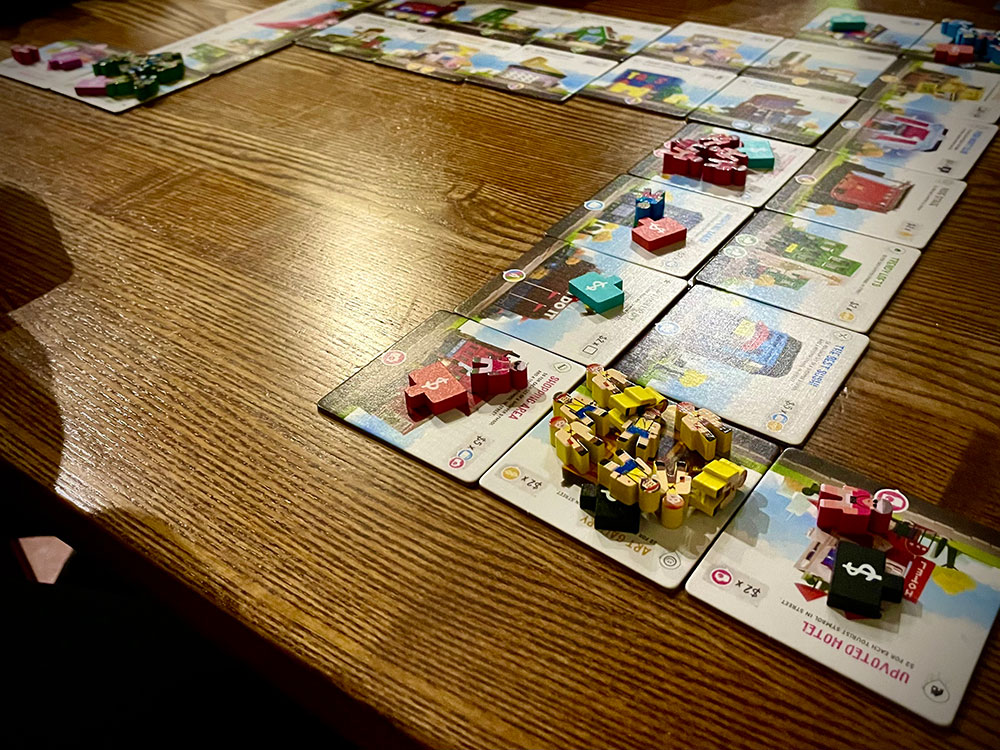
Game Experience
Streets is a game about Tile Placement and Set Collection. Every turn is a mini puzzle, as there are endless possibilities of where you can place your Building tiles. Make a wise choice and make a lot of profit when the street is scored or make a poor placement and you may earn little or nothing from the property. Every game, a completely different city is built, and the winning strategy you’ve once adopted may not be the best fit during a new match.
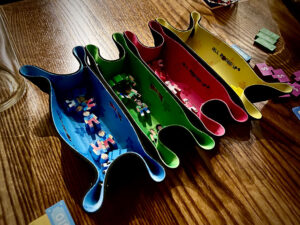
The game’s stochastic contingency results from the designed uncertainty mechanism of drawing a new card at the end of each turn. It can significantly impact the player’s strategy, especially considering that this is a Set Collection game. Property valuation is mainly determined by sets of buildings or meeple types on an enclosed street. Still, the player has significant agency to pivot their strategy middle game based on their current hand cards. The game’s designed uncertainty is an excellent asset to Streets, adds a lot of variability to the game, and guarantees that different matches will never feel samey. Replay value is definitely high in Streets, especially with plenty of mini-expansions and rule variants.
Social contingency is also very unique in Streets. When a property is sold, the current player can decide where its meeples will move next. This mechanism can be a deal breaker and flip the game’s odds in one well-played turn. This mechanism provides a lot of engagement during downplay.
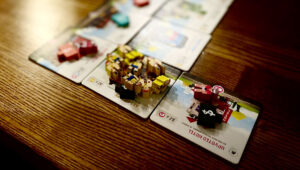
Ultimately, Performance Contingency determines the outcome of a game. As players have considerable agency and decision-making power, you need superior planning and mastery if you want to compete successfully.
One of the Streets’ greatest strengths is its unique fictional involvement due to its innovative, outstanding components, artwork, and consistent use of humor. Undoubtedly, this game’s tactile and aesthetic elements will appeal to players. Every game piece is designed gracefully so that the final and completed City shines on the table. You can be sure that it will catch the attention of anyone who happens to be passing by.
Final Thoughts
Due to its simple, easy-to-learn rules, fast pace, and unexpected complex strategy, Streets delivers impressive Ludic Involvement. Low complexity, easy setup, short downtime, and consistently engaging competition make the game an excellent choice for those looking for an easy-to-play but deep-tactical game.
Final Score: 4.5 Stars – Streets is a surprisingly entertaining and consistently engaging competitive game with plenty of variety and superb aesthetics. Streets does not get 5 stars because it uses very well-known game mechanics, yet with a unique approach and its own twist to the Tile Placement genre.
 Hits:
Hits:
• Low complexity, easy setup, and short downtime.
• Easy-to-play, fast-paced, deep-tactical game.
• Outstanding components, artwork, and consistent use of humor.
• It is a compact game that incredibly packs so much content.
Misses:
• Beginning players may mistake it for an “easy game” due to its simple rules. This is not an “easy game”.
• Experienced players have a significant advantage against new players.
• Don’t be fooled by its attractive looks. The game is deceptive and geared toward the expert crowd.
This game was originally published in Roll & Mind.
CreditSource link







